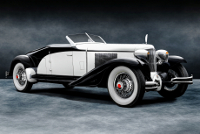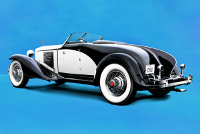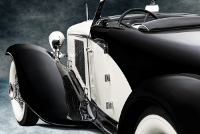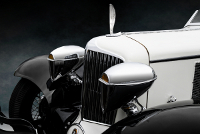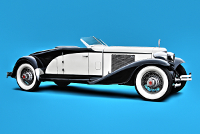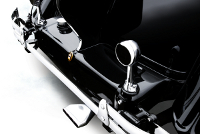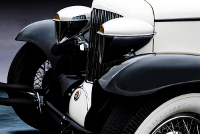Location:
Pebble Beach Concours d'Elegance, 2009
Owner: Ed & Judy Schoenthaler | Oak Brook, Illinois
Prologue:
Though it may be some while before we do up A-C-D proper, I worked through a concise profile on this L-29 quite early in the 12cylinders odyssey. The notoreity of the car fostered my interest, as did its connection to a man who was part of the American industrial design firmament. In retrospect, my survey is quaint and the images not bad. I've let the piece stand for years until I return to reflect more deeply on the L-29 along with the half-dozen glitzy examples we've encountered since.
- - - - - - - - - -
► Image Source: Nikon D200 (10.2 MP)
References:
- Special Interest Autos: SIA Profile, "Brooks 'Kip' Stevens" by Richard M. Langworth, October, 1982
- Hemmings Daily: The blog provides numerous articles on Brooks Stevens, including copies of the SIA piece above, and a complete Brooks Stevens Automotive Museum brochure.
- Rides with Chuck: A nice video walk-around and ride-along with owner Ed Schoenthaler.
With the help of his father, Brooks Stevens acquired this Cord L-29 in the early thirties, slightly used, and soon enough decided to personalize it with his own design. Cord's Limousine Body Company carried out the plans, and Brooks kept the car for more than sixty years until his death in 1995. Well traveled along the recent concours scene, Brooks' personal Cord was nominated in 2016 for the International Historic Motoring Awards Car of the Year, receiving consideration after winning Best of Show at Amelia Island.
Brooks Stevens, Industrial Designer
"He is beyond any real question one of the supporting pillars of the automotive community, both of the manufacturers and of the vintage community." So wrote Special Interest Autos in a lengthy profile on Brooks "Kip" Stevens back in 1982. Within today's automotive community, the name is in some large sense lost, owing to the fact that many of Stevens' automotive employers are themselves gone. He spent much of his time in the automotive industry designing for Kaiser before advancing the image of Studebaker in the sixties, a decade the marque would not survive.
However, if any of his motorized contributions could remain corporeal in the sense of our collective memory, then perhaps we'd need to mention, first, the Harley-Davidson Hydra-Glide, and second, the Jeep Wagoneer. Of course, we should also remember that Stevens chose to act more so as a company than as an individual talent. "Kip always referred to such efforts in the first person plural—'we' did this or that. This was only because he wanted to make it clear that Brooks Stevens Associates was not a one-man company."
After studying architecture at Cornell, the economic realities of the classic era and its lack of construction projects pushed Stevens into the design field. He worked on projects ranging from farm tractors to marine engines to beer cans, and he performed work in about a half-dozen countries. His name is even linked with post-War Alfa Romeo and the 6C 2500. So, although we make a big to-do about the people whose designs excite us, we must acknowledge the breadth of influence Stevens had on the better part of twentieth century design. Oh yes, and the Oscar Mayer Wienermobile—that was Stevens' design, too.
Today, Brooks Stevens is still an active industrial design firm working out of Milwaukee, Wisconsin, where Brooks founded the company in 1934. As Brooks Stevens, Inc. declares, (or at least declared at one point), "Brooks Stevens was responsible for the design of over 2,000 products for over 600 clients in a career that spanned 60 years. He was one of the ten original charter fellows of the Society of Industrial Designers in 1944, and the only one not from New York."
Motor: 4,893 cc Lycoming straight 8-cylinder, cast iron block and head | 83 mm x 114 mm | 5.3:1 compression
Valvetrain: side-valve, 2 valves per cylinder
Aspiration: twin Schebler SX437 duplex carburetors
Drivetrain: 3-speed gearbox, front-wheel drive
Front Suspension: de Dion axle, quarter-elliptic leaf springs with Houdaille-Hershey hydraulic shock absorbers
Rear Suspension: beam axle, quarter-elliptic leaf springs with Houdaille-Hershey hydraulic shock absorbers
Architecture: pressed steel ladder frame chassis, X-bracing, with coachwork by Limousine Body Company
Etymology:
Errett Lobban Cord revived the Auburn Automobile Company, gave Duesenberg carte blanche to develop the ultimate car, and purchased Lycoming Engines to provide motive his personal empire. So the namesake brand of Cord fit snuggly between the others, though interesting not at the top of the range. The first offering within the Cord brand took the less-used 'L' designation, after 'Lobban,' and was first underway in 1927 as the L-27 prototype. The production car thus emerged as the L-29 in 1929.
Figures:
Cord produced roughly 5,000 of the L-29 from 1929 to 1932, only a handful of which are speedsters. Brooks Stevens' personal car is unique, and has survived with Stevens' modifications. The Schoenthalers knew Brooks Stevens and acquired the car from his family after the designer's passing in 1995, promising to restore the car exactly as configured.
Forward-Leaning: Cord L-29 Modifications by Brooks Stevens
The design of this Cord L-29 isn't standout revolutionary, (Stevens would get on to that), but rather tastefully sleek. As if America's dashing classic needed further trimming, Stevens drafted an even lower cowl and narrower body, opting for a set of woodlights to complete a more aggressive theme. He replaced the bonnet louvres with Duesenberg-style screens for added cooling, not a shoddy idea considering this Lycoming 8-cylinder breathes through a twin-carb intake manifold of his own design and churns out puff through a custom exhaust. He also altered the final drive ratio to make the car apt for hill climb competition.
Stevens designed his own mascot, an Art Deco wing, (wholly unique to, and specifically cast for his car), and replaced the dashboard with Duesenberg-type instruments because the stock gauges proved too difficult to read. The dash panel itself is more mechanically hot rod-inspired, as Cord used a series of crackle-finish plaques that resemble silver serving trays more than gauge clusters. Up ahead, Stevens swapped the flat-pane windscreen for a vee unit, and did away with wipers on the ambition of keeping the car out of the rain and therefore never needing them.
At the corners, Stevens completely reworked the running gear. He skirted the sleek front fenders—note the closed-in eaves alongside each—then discarded the side-mount spares and smoothed-in the coves in which the spares normally sat. He removed the running boards and installed a polished kick-plate on the leading edge of the rear fenders. These alterations give the car a launching, gull-wing stance, and the strident slide of the long front fenders nicely complements the taper of the tail.
European Influence: French Styling in the Brooks Stevens Speedster
The Brooks Stevens speedster uses a Figoni-style sweep to divide the body, creating a smooth departure of simple, complementary curves. This pattern is wholly different from the Duesenberg sweepside cove, descending to the base of the rear fender in the continental style. Interesting from the rear quarter perspective is how these lines match one another through the tail—these being the panel sweep, fender, deck, and dorsal fin. All clad in black, the curves replace chrome, with the exception of the fin's rim, relying on a design that pairs the slope of the front skirts with the declination of the flank, absorbing much of the wheelbase with a keen sense of proportion. All told, the effect is dashing, a sporty design made even more slender at the nose, and bolder—if a bit tacked on—at the rear. The tail fin is also a largely continental contrivance, whether of an Italian or French inspiration. The fin closes access to the boot, (and so much for the original rumble seat), but for storage access the cabin seats fold down.
In sum, the Cord's alterations comprise a design that illustrates complete understanding of classic era automotive trends, both the leading edge and where the trends were headed. Stevens made the car do what he wanted aesthetically, equaling the grace of the time's best custom design work, but also retained the inherent beauty of the L-29. In so doing, he created the ultimate expression of the Cord speedster, appropriate open counterpoint to Alexis de Sakhnoffsky's remarkable Hayes Coupe.
Last Updated: Mar 26, 2025

